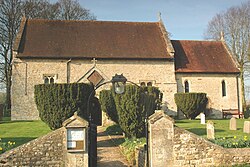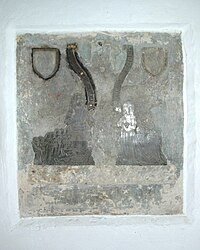Cottisford
| Cottisford | |
| Oxfordshire | |
|---|---|
 St. Mary the Virgin parish church | |
| Location | |
| Grid reference: | SP591312 |
| Location: | 51°58’35"N, 1°8’24"W |
| Data | |
| Population: | 216 |
| Post town: | Brackley |
| Postcode: | NN13 |
| Dialling code: | 01280 |
| Local Government | |
| Council: | Cherwell |
| Parliamentary constituency: |
Banbury |
Cottisford is a village in Oxfordshire, about three and a half miles south of Brackley in neighbouring Northamptonshire. The parish's northern and northwestern boundaries form part of the boundary between the two counties. The parish includes the hamlet of Juniper Hill about a mile north-west of Cottisford. The 2011 Census recorded the parish's population as 216.
The village stands beside Crowell Brook, which is a stream that passes the villages of Hethe, Fringford and Godington before entering Buckinghamshire where it becomes part of Padbury Brook, a tributary of the Great Ouse. Cottisford's toponym refers to a former ford across Crowell Brook. In the 13th century the village was called Wolfheysford or Urlfesford.[1]
Manor
The Domesday Book records that in 1086 Hugh de Grandmesnil was feudal overlord of Cottisford Manor and his son-in-law Roger d'Ivry was the lord of the manor. After d'Ivry's death his widow Adeline gave Cottisford to the Benedictine Abbey of Bec in Normandy. Bec Abbey owned Ogbourne Priory in Wiltshire, which administered many of the abbey's English manors including Cottisford.[1]
Ogbourne was an alien priory, which is to say it belonged to an abbey outside the English realm. In 1404 Henry IV was planning a military campaign in France so he granted Ogbourne Priory and all its manors jointly to his son John of Lancaster, the churchman Thomas Langley and the Prior of Ogbourne: William de Saint Vaast. The Prior died soon afterwards; in 1414 Henry V suppressed the priory and by 1422 Thomas Langley had surrendered his share of the rights to the manors to John of Lancaster, whom Henry V had made Duke of Bedford.[1]
Manor Farm is a 14th century manor house built of rubble masonry. Surviving 14th century details include two windows and an octagonal chimneystack. Four more windows date from the 15th century. The house has a solar and originally had a mediæval hall, but in the 16th century an intermediate floor was inserted to create upstairs rooms. Also in the 16th century a south wing containing a parlour was added. The house was enlarged again in the 19th century. A 12th-century window in the north gable of the house is not original to the house and must have been salvaged from a building elsewhere.[2] The house is a Grade I listed building.[3] On Crowell Brook just below Manor Farm is a set of fishponds, the earliest record of which is from 1325.[1]
Cottisford House is a newer manor house built before 1707. It is of coursed rubble with ashlar quoins and has a hipped roof with attic dormers. William Turner, who leased the house from 1825,[1] had the house altered and enlarged in about 1830.[2] In its grounds is a square dovecote.[1]
A watermill was built in about 1230, presumably on Crowell Brook. In 1292 the parish had both the watermill and a windmill. Neither mill's fate is clear, but by the second half of the 18th century the estate seems to have been using a mill at Fringford instead.[1]
An open field system of farming prevailed in the parish until 1854. Attempts by successive lords of the manor to get Parliament to pass an inclosure act for Cottisford's common lands were defeated in 1761, 1777 and 1809. Parliament finally passed an inclosure act for the parish in 1848 but the enclosure award to redistribute the land was not settled until 1854.[1]
The enclosure award included setting aside a plot of land for a village school. In 1856 the school and adjoining schoolmistress's cottage were built with funds provided by Eton College. The parish church ran it as a National School until it closed in 1920.
The author Flora Thompson[4] (1876–1947) grew up in Juniper Hill and was a pupil at Cottisford School. She wrote the Lark Rise to Candleford trilogy of novels, in which she modelled the village of "Fordlow" on Cottisford.[1]
Parish church
It has been suggested that parts of the Church of England parish church of St Mary the Virgin may be Saxon. It has proportions like those of a Saxon church: long and narrow, and taller than it is wide. The quoins at all four corners of the building are a puzzle. On the one hand they are a mixture of long flat slabs and tall narrow blocks, like Saxon quoins in many other buildings. On the other hand, the quoins are not laid in the strict long-and-short alternation diagnostic of Saxon work.[5]
All the windows are certainly later work, but in the nave the windows in the west wall and in the western parts of the north and south walls are high up, in positions similar to where Saxon windows would have been positioned. Low down in the east wall is a blocked arch very roughly made of uneven stones. It is of such rough workmanship that it could be from any period, but if it were Saxon it would be the wall of a porticus.[5]
Cottisford certainly had a parish church by 1081, when Hugh de Grandmesnil gave it, along with its tithe income and a hide of land, to the Benedictine Abbey of Saint-Evroul-sur-Ouche. In 1167 St. Evroul Abbey transferred its property, tithes and land at Cottisford to Bec Abbey, which by then owned the manor of Cottisford.[1]
St. Mary's was rebuilt in the 13th century. It is a small building with only a nave, chancel and south porch. The porch is Early English Gothic and has a sundial. The east window of the chancel dates from about 1300. The Gothic Revival architect Charles Buckeridge restored the building in 1861[2] and the present font was added at the same time.[1] There is no bell tower but there is a belfry in the apex of the roof. The church had two bells in the 16th century.[1] These have not remained but the church now has two bells cast in 1710 and 1858 and a small 17th century sanctus bell.
In the churchyard are the base and shaft of a mediæval stone cross.[2] St. Mary's is a Grade II* listed building.[6]
St. Mary's is now part of the Shelswell group of parishes.
| ("Wikimedia Commons" has material about Cottisford) |
References
- ↑ 1.00 1.01 1.02 1.03 1.04 1.05 1.06 1.07 1.08 1.09 1.10 1.11 Lobel, 1959, pages 103–116
- ↑ 2.0 2.1 2.2 2.3 Sherwood & Pevsner 1974, p. 558–559.
- ↑ National Heritage List 1046440: Old Manor Farmhouse (Grade I listing)
- ↑ Friends of Flora Thompson
- ↑ 5.0 5.1 Milnes-Walker 1978, p. 255–256.
- ↑ National Heritage List 1046439: Church of St Mary (Grade II* listing)
- Blomfield, James Charles (1887). Deanery of Bicester. Part III: History of Cottisford, Hardwick and Tusmore. Bristol: JW Arrowsmith.
- Horn, Joyce M (1986). Volume 6, Salisbury Diocese. Fasti Ecclesiæ Anglicanæ 1541–1857. pp. 93–105.
- A History of the County of Oxford - Volume 6 pp 103-116: Parishes: Cottisford (Victoria County History)
- Milnes-Walker, H (1978). "A Saxon Church at Cottisford?". Oxoniensia (Oxfordshire Architectural and Historical Society) XLIII: 255–256.
- Nikolaus Pevsner: The Buildings of England: Oxfordshire, 1974 Penguin Books ISBN 978-0-300-09639-2
